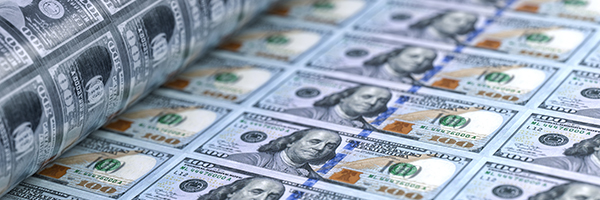 April 26, 2025
April 26, 2025
What You Need to Know Today:
Economic models on Wall Street say odds of a recession are rising
The odds of a U.S. recession are still low, but an increasing number of Wall Street economic models say the odds are climbing.

Adding this dollar ETF to my Perfect 5 ETF Portfolio
Last week I sold my commodities ETF, the VanEck Agribusiness ETF (MOO) out of my Perfect 5 ETF Portfolio.
Today I’m replacing it with the Invesco DB U.S.Dollar Bullish ETF (UUP), UP 0.82% in 2025 as of January 14, 2025. The ETF gained 13.48% in 2024.

Big market reaction on a tiny move in CPI inflation
As of noon New York time today, January 15, the Standard & Poor’s 500 was ahead 1.30%. The NASDAQ Composite and the small-cap Russell 2000 were both up 1.80% on the session. Today’s big moves come on relatively minor changes in inflation trends in this morning’s report on CPI inflation in December. And I think they have more to do with how afraid Wall Street is that the Federal Reserve isn’t going to deliver at least one or two interest rate cuts in 2025 than with any big news in today’s report. The consumer price index (CPI) rose at an annual rate of 2.9% in December, up from a 2.7% annual rate the previous month. That increase was in line with expectations. On a month-to-month basis, the index rose 0.4%. The “core” index, which strips out volatile food and energy prices and is much more important to the Fed than the headline inflation number, rose at a 3.2% annual rate in December. That was down slightly from its annual rate of 3.3% in November, and less than economists had expected. It’s this dip in the annual rate of core inflation that has investors feeling so optimistic today.

More oil and lower oil prices into 2026
Global oil markets will face a widening glut in 2026 as OPEC brings back production and output from the United States, Canada and Guyana continues to grow, the U.S. Energy Information Agency said today, Tuesday, January 14. Today’s forecast was the agency’s first for 2026. World oil markets are expected to average a surplus of 800,000 barrels a day in 2026, the Energy Information Administration. That’s more than twice as large as the 300,000 barrel a day surplus the agency projects for 2025.

The BIG QUESTION: Does the selling in the stock market go farther? I think yes–and here’s what to do
Enough downside still ahead so that it makes sense to sell some of your portfolio, take some profits, and raise cash on the prospect of a buying opportunity or two ahead? In my opinion, Yes.

China’s trade surplus hits $1 trillion just as Trump takes over trade policy
On Monday, January 13, China announced that its trade surplus reached almost $1 trillion in 2024. China’s General Administration of Customs said the country exported $3.58 trillion worth of goods and services last year, while importing $2.59 trillion. The surplus of $990 billion broke China’s previous record, which was $838 billion in 2022. Strong exports in December, including some that may have been rushed to the United States before President Donald Trump can take office and raise tariffs, propelled China to a new single-month record surplus of $104.8 billion. When adjusted for inflation, China’s trade surplus last year far exceeded any in the world in the past century.

Special Report: 10 Great Growth Stocks that Are Getting Greater–today my 10th (and final) pick QCOM
GREATER Growth Stock Pick #10: Qualcomm (QCOM). I think the market and the current stock price are missing a good prt of the growth story for Qualcomm. Which is why I find the stock undervalued enough to buy here. Right now the market disagrees. However, I’ll be adding the stock to my Jubak Picks and Volatility Portfolios on Tuesday, January 16.
Live Market Report (20 minute delay)

The “other” big interest rate news tomorrow: How big will the Treasury’s bond auctions be?
The Federal Reserve will announce its interest rate decision on Wednesday–the market currently expects no change to policy interest rates. But I’d argue that the bigger news on internet rates for the day will come when the Treasury announces how many notes and bonds it intends to sell in auctions from November through January. Right now, it looks to me like the bond market is driving interest rates rather than the Fed so the number of bonds Treasury needs to sell is likely to set interest rate trends for the next few weeks. Bloomberg’s survey of Wall Street primary bond dealers shows that the consensus projection for the quarterly refunding sales announcement—including 3-, 10- and 30-year Treasuries— is for a $114 billion total, up from the $103 billion total three months ago.

Step #8 in my Special Report: Sell DE, CAT and BHP tomorrow
Today I posted Step #8 in my Special Report: 8 Steps to Protect Your Portfolio from the Global Debt Bomb. I recommended selling Deere (DE), Caterpillar (CAT), and BHP Group (BHP) out of portfolios ahead of rising yields i the bond market. (In the case of Deere, I said I would keep my position in my long-term portfolio but sell the position in my 12-18 month portfolio.) Here’s what I posted in my Special Report

Step #7 in my Special Report: Sell GM and Ford sometime between now and December
I added Step #7 to my Special report: 8 Steps to Protect Your Portfolio from the Global Debt Bomb today. And my advice is to sell Ford and General Motors sometime between now and before the December 13 meeting of the Federal Reserve. Here’s what I wrote in that Special Report.

I’ve added the last 2 steps to my Special Report “8 Steps to Protect Against the Global Debt Bomb”
This morning I added Step #7 and Step #8 to my Special Report on how to protect your portfolio agains the coming global debt bomb. And I promised Step #9 on what to sell in the technology sector by the end of this week.

Saturday Night Quarterback says, For the week ahead expect…
To catch you up in case your eyeballs have been focused elsewhere (and there’s certainly a lot of elsewhere to watch right now). First, the Russell 2000 broke below its July high. Then the NASDAQ Composite followed (down 12.2% from the July 31 high at the close on October 26.) Then the NASDAQ 100 joined in (down 10.9% as of the close on October 26.) And finally on Friday, October 27, the Big Daddy, the Standard & Poor’s 500 extended its slide from its July high to 10%. All thee indexes are now in correction. (Defined as a drop of 10% or more from the previous high.) The index and correction that worries me the most? The NASDAQ 100.

Amazon and Intel both soar on earnings but don’t take the wider market up with them–that’s not a good sign
You can tell a lot about market sentiment by watching how it reacts to good news from individual stocks. Yesterday, both Amazon (AMZN), a current market leader, and Intel (INTC), a former market leaders and still an important technology sector stock, both reported...

PCE, the Fed’s favorite inflation measure, comes in unexpectedly hot in September
The Personal Consumption Expenditures index, the Federal Reserve’s preferred measure of inflation, accelerated to a four-month high in September. The core Personal Consumption Expenditures index, which strips out volatile food and energy prices, rose 0.3% in September from August, according to the Bureau of Economic Analysis. As with this week’s report of a surprisingly strong 4.9% annual GDP growth, the “culprit” in today’s surprise was strong consumer spending. Inflation-adjusted consumer spending jumped 0.4% last month. The numbers in this report for inflation and earlier this week for GDP growth argue that the Federal Reserve might consider another interest rate increase in the remainder of 2023. But Wall Street sentiment doesn’t agree with that view.

More technical breakdowns: NASDAQ falls into correction
The NASDAQ Composite was still up 23.75% as of the close on October 25. But the index is now down 12.2% from its July 31 high as of the close on October 26. That’s correction territory.

At 4.9%, third quarter GDP growth is even hotter than feared
The U.S. economy grew by an annual rate of 4.9% in the third quarter, the strongest pace since 2021 and twice the pace of growth in th second quarter. Before the report from the Bureau of Economic Analysis, economists surveyed by Bloomberg were expecting annual growth of 43%. Growth at that rapid a pace, they worried then, could lead the Federal Reserve to consider raising interest rates at its November 1 meeting. Obviously now, after growth at 4.9% far exceeded projections of 4.3% growth, those worries are a little more pronounced. But only a little.

Selling utilities Duke and NiSource on higher yields elsewhere
Today, in my Special Report: 8 steps to Protect Your Portfolio from the Globlal Debt Bomb, I advised raising some cash my selling two utility stocks, Duke Energy (DUK) and NiSource (NI) out of my Dividend Portfolio tomorrow.

Buy (more) of the ProShares Short Russell 2000 ETF to short small caps in this credit crisis
Today I’m adding the ProShares Short Russell 2000 ETF (RWM) to my Jubak Picks Portfolio.

Special Report: 8 Steps to Protect Your Portfolio from the Global Debt Bomb–complete 8 steps
I’ve hi-lighted the key characteristics of the coming global debt bomb explosion that investors MUST include in any plan to protect a portfolio from the explosion of this bomb.

The technicals look increasingly awful for stocks
I know the bond market is getting most of the headlines at the moment. And it should be. By some measures, volatility in the Treasury market, you know, the old safe haven Treasury market, exceeds volatility in equities. And then there’s the drama of watching the assault on 5% yield on the 10-year Treasury. The drama isn’t just theatrics either. Above 5% yield on the 10-year Treasury there’s an increasing likelihood that something in this over-stretched credit market will break. But…you can’t ignore the stock market. The technical picture is increasly scary. Here too something looks like it could break–and not in a good way.

Please note I’ve just posted an update to my Special Report: Your 10 Best Moves for the Rest of 2023
The update to my Special Report: Your 10 Best Moves for the Rest of 2023, Part 2–10 of 10 Moves (revised on 10/22) includes the last one of my 10 picks, plus updated performance numbers for the stocks in the original post.I’m pleased to say that I think the advice is still what I would give today.

Saturday Night Quarterback (Part 2) says, For the week ahead expect…
Investors see a ton of third-quarter earnings reports this coming week with news from Microsoft, Amazon, Meta Platforms, and Alphabet quite capable of moving the entire market. We’ll also get more consumer company (Coca-Cola and Kimberly-Clark for example) reports to show whether last week’s higher revenue but lower volume pattern continues. And Wall Street is expecting negative new from oil companies ExxonMobil (XOM) and Chevron (CVX) when they both report on Friday.

Saturday Night Quarterback (Part 1), says, For the week ahead expect…
The U. S. economy, economists project, grew at the fastest rate in nearly two years in the third quarter. The actual figures from the Bureau of Economic Analysis get released before the market opens on Thursday, October 26. Gross domestic product grew at a 4.3% annualized pace in the quarter, according to the median projection in a Bloomberg survey of economists.

The 5% yield barrier on 10-year Treasuries is going to fall–soon
The yield on the 10-year Treasury closed at 4.99% yesterday. Bond prices are up a bit today, Friday October 20, and as of 1 p.m. New York time, the yield on the 10-year had retreated 8 basis points to 4.91% I don’t think this changes the trend line–which is clearly pointing toward yields above 5%. I’m watching that level carefully for two reasons.

Abbott earnings look to make successful reset from Covid sales boom–and to overcome GLP-1 fears
Yesterday, October 18, Abbott Laboratories (ABT) reported third-quarter 2023 adjusted earnings of $1.14 per share. That beat the Wall Street consensus projection of $1.10 a share. This was an important transitional reset quarter for Abbott

Another day, another 8 basis points
Today, October 18, the yield on the 10-year Treasury rose to close at 4.91%. That was a gain in yield of another 8 basis points. The yield on the 10-year Treasury is up 61 basis points in the last month.

Procter & Gamble, like PepsiCo, reports higher revenue on lower volumes
There’s a pattern here: If you’re a big enough consumer goods company with the ability to raise prices and not hurt sales, then the just-ended quarter was a pretty good quarter. Today, October 18, Proctor & Gamble reported fiscal first quarter net sales of $21.9 billion, up 6% from the prior year vs.a Wall Street consensus projection of $21.62 billion.



